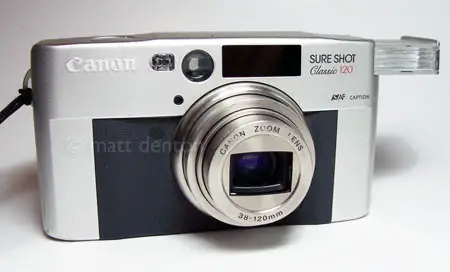- Produced 1999 Canon Co. Tokyo, Japan
- Film type 135 (35mm)
- Picture size 24mm x 36mm
- Weight 250g (255g QD date model)
- Lens Canon 38-120mm f/4.5-10.9, 7 elements (1 molded aspherical) in 6 groups
- Focal range 3′ to infinity
- Filter size 43.5mm screw-in (45mm slip-on)
- Shutter Canon electromagnetic shutter
- Shutter speeds 4s – 1/770 in multiple modes
- Viewfinder 84% coverage zooming viewfinder 0.43x – 1.36x
- Exposure meter CdS
- EV range 3.5 – 18.5 @ ASA 100
- Battery 2x 3V CR-2 lithium batteries
- ASA 25 – 3200 DX
- Flash GN 11 at 38mm, 15 at 120mm, 3s recycle, daylight sync
- 3 point hybrid AI-AF (manual select point focus)
- 7 shooting modes: auto, spot, action, night scene, close-up, portrait, personal*
- automatic film loading
- Self-timer
Overview
The little camera with a big name! How could I not add this one, it says Classic right in the title! Plus it’s dear to my heart. I bought this full-featured little treasure as a replacement for our previous family camera, a Sure Shot Owl, which served us well for a time. Once we had kids we needed something more full-featured that was easy to carry, easy to use and could take professional-looking pictures in various situations. After being impressed with my in-laws’ Sure Shot Z115 (which is larger but zooms faster), I researched and bought the Classic 120. We used it daily for years, until it was in turn displaced by the Nikon N6006 and then a year later by the Kodak Easyshare CX7330 (as a class mom she felt she needed to ‘go digital’ for convenience. I think you see how this works.
The Classic 120 is very full-featured for an autofocus point-and-shoot, with a 38-120mm zoom, diopter adjustment, +- 1.5EV adjustment, and preprograms for such things as backlighting and macro. However we found that it’s not the greatest stealth camera as the motor noise it makes when switched on often distracts the young subject out of the pose that caught our eye in the first place. The styling of it is supposed to recall the classic rangefinders such as the Canonet QL17 or Konica C35 Automatic, thus the ‘classic’ designation.
Not obvious to the eye is the internally preprogrammed exposure information that supposedly contains over 1200 different lighting schemes to compare your subject to, in an effort to make sure it is evenly exposed. This in lieu of matrix metering I suppose but it seems to know 9 times out of 10 how to properly expose a scene. Again, this is the closest to SLR quality I’ve ever seen in a compact 35mm.
*one of the coolest features of this camera is a “personal” setting on the mode dial, you can program your favorite settings such as exposure compensation, focus mode, flash mode, and recall them with the flip of the dial. Super-sweet!
Repairs
It did once stop working after being dropped one too many times, and I sent it in for an estimate, and was told it would be a flat $85 for repair. So needless to say I bought another on Ebay for $35. Note – my in-laws’ Z115 has had to be sent in for repair of the zoom motor, it used to give an E error message, I think that happens with some regularity with the Z115, it happened a second time after repair and I bought them another on ebay. Why the loyalty? I have to say, I’ve used a slew of AF compacts from Pentax to Nikon to Olympus and everything in between, and these are the only ones I’ve used that consistently take SLR quality pictures.
Tips & Tricks
Set the dial to running man for moving subjects, it tracks with continuous focus; set to flower for close up and use the alternate marks in the viewfinder. Otherwise leave on auto and focus with the center spot, then recompose if necessary.
Important – use the soft carrying case when tossing this one in a backpack, the blades that protect the lens are very susceptible to accidental damage!
Related Links
- Some info at Canon’s Camera Museum site
